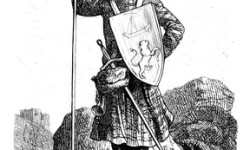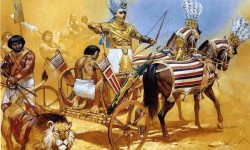A phalanx is a dense, linear combat formation of heavily armed infantry, usually equipped with a shield and spear, and marching side-by-side on the enemy in multiple rows.
This term is particularly related to the frequently mentioned battle formations in the Greek - Persian War. However, since the 18th century, this term has also been used for general formulation in self-contained series and formations.
It is now believed that the origin of the formation in the military sense was already applied before the Greeks in the Sumerian Empire. The year 2440 or 2430 BC. Geierstele of the King Enneatum from Lagasch, who dated to a few years BC, shows on several fragments densely closed fighters on foot, who proceed armed with shield and spear.
In Greek antiquity, the phalanx initiated the transition from individual to formation struggles. It was probably built by the Spartans in the 7th century BC. It was made up of armored hoplites armed with a lance that was originally about two meters long and later became longer (up to seven meters). This lance was often also provided with a bronze tip at the lower end of the shaft. This served to ram the lance into the ground in case of an enemy cavalry attack. As a result, she offered the riders more resistance than if she was held by a soldier, and thus created an almost insurmountable obstacle. In addition, the rear tip could be used as a secondary weapon in case the lance broke, or in case the lance was still whole, used to stab at fallen opponents that were moved in the forward motion. The phalanx was a closed linear formation composed of several limbs of hoplites.
Originally the phalanx was probably 8 limbs in open and 4 limbs in closed order deep. Later, the lineup usually had a depth of 7 to 12 men. One problem of linear deployment with phalanx-type armament and equipment was the desire of each phalangite to place its unprotected right-hand side in the shield of its right-hand man's shield. As a result, the Greek-style phalanx had a clear tendency to move to the right. The commonality of the Greek armies in these habits meant that during the battle both phalanges turned parallel in a counterclockwise direction. The more powerful because of his elite lineup right wing usually won against the opponent, corresponding less less powerful left wing of the opponent. Theoretically, it was conceivable that each of the two right-hand wings beat their opposite wings and thus became free for the thrust in the back or the deep flank of the opponent. Therefore, in the battle, the army defeated the first to succeed on their right wing. Once this was done, the opponent usually volunteered to clear the field and not let it come to extremes.
In clear recognition of these connections, the Theban commander Pagondas at the Battle of Delion (424 BC) changed his phalanx so that he strengthened his right wing to a depth of 25 men. This should make it possible to advance so quickly on the right and smash the enemy's left wing, leaving him no chance of succeeding on the other wing in a comparatively short time. Fifty years later, Pagondas' countryman Epaminondas extended this tactical approach to a completely new order of battle, which went down in history as an oblique order of battle and was counted among the most significant tactical developments. In the Battle of Leuktra, Epaminondas reversed the classic concept of the phalanx and placed his best fighters on the left rather than the right wing. He also reinforced this wing to a depth of 50 men. As a result, at the Battle of Leuktra, the elites of two armies collided for the first time. The extreme depth of his left wing should ensure a safe and quick victory over the enemy attack wing. At the same time he held back his exceptionally less powerful right wing and did not intervene in the battle, whence the order of battle also got its name "wrong" (the armies did not collide, but at an acute angle to each other).
The next evolution of the phalanx happened under the Macedonian king Philip II. The military successes of the Macedonians in the 4th century BC. Among other things, they were justified by their further development of the phalanx tactics. The Macedonian phalangites wore only light armor, which greatly increased the Macedonian army. Much of the Macedonian infantry, the Companions on foot, was armed with a lance more than five meters long, the Sarissa. So that fallen opponents could not straighten up again, the back rows of the Pezhetairen stabbed at the advancing with the also pointed, lower end of their Sarissa on them. After the death of Alexander 323 b. Chr. The Diadochenkriege, in which Sarissen with a length of up to 7 meters were used.
For close combat, the Phalangites were armed with a short sword. Since they were barely trained in swordplay and their strength in the fight with the long weapons, they avoided the close combat as possible. This was especially dramatic at the Battle of Pydna, when the Macedonian phalanx was unable to maintain its cohesion on uneven terrain. In the resulting gaps met the specialized on melee Roman soldiers and destroyed the Macedonian phalanx. The escape from a phalanx was nearly impossible.
Application of the phalanx in the Roman army
Like the Greeks, the Romans fought in battle in numerous individual battles. Under Greek influence, in the Roman army, in the course of the army reform, the army was forced to fight in a closed battle line. The phalanx (see also Classis) of the Roman infantry was initially staggered by the armor and armament of the soldiers, with the heavily armored fighters in the front rows and the lightly armored in the last rows. Later, it was decided to stagger the legionaries by experience, the most experienced (Triarier) as backing back (hit tactic).
In addition to this minor change, a basic phalanx deficiency was eliminated by the Romans. Around the year 400 BC They introduced the manipular phalanx (manipulation tactics), which was no longer as rigid and immovable as their Greek model. Although the Greeks had left between their army departments (Lochoi) small spaces that could be closed quickly in the event of impending enemy break-ins, the Romans used the hitherto only administrative unit of the manipulated but also tactically. The mansions were like a checkerboard, but in such a way that the gaps in the front of the foremost manipel were too narrow for those behind, but wider than in Greece. As a result, on the one hand, the rightward pull of the total phalanx was reduced. On the other hand, the front manicula received freedom of movement, as they no longer had to fear bumps into the flank. As soon as a sufficiently large gap had been created, a follow-on couplet immediately moved in, closing the front again. The Romans had rid the phalanx of their rigidity and - as Delbrück put it - provided with joints.
200 years later, the concept was further refined by introducing the hit tactic. In addition to immobility, other major problems of the Greek phalanx were their vulnerability to flank attacks and their inability to pursue the defeated enemy. Both problems were solved by the hit tactics. Simplified, stood several manipular phalanges in a row, which could help on the one hand by closing gaps, but were also available for the fight in the flanks or as a reserve, for example, for the pursuit.
Another 100 years later, the phalanx reached the end of its development with cohort tactics. In the cohort as a tactical body, the Romans had, while maintaining the previous stages of development an independent association that could form the phalanx with other cohorts, as well as was alone capable of and could be used. In addition, the cohort provided a large enough military body for a variety of military tasks. The phalanx had thus become a complex organism that could be expanded or dissolved as needed without losing its tactical value.
Subsequent related formations
From the Migration Period to the late Middle Ages, the infantry, in the sense of orderly infantry, dwindled from the battlefields. Only the Swiss took up the idea of the phalanx after the Macedonian pattern again. There are, however, some serious differences between the phalanx itself or even the special Macedonian phalanx and the swastika. The man-made structure was a mixture of different weapon carriers. Although the outside marching fighters had the long spike, which reminds of the Sarisse, but in between were fighters with handguns. Later, ranged gunmen (crossbowmen, arquebusiers, musketeers) immediately joined the bandage of violence. This mixture of armaments had not existed in classical phalanges, archers and the like were never part of the phalanx. Another difference was that the stockpiles were not made arbitrarily wide, but either had a balanced ratio of width to depth, or had more depth than width. Several manholes (usually three) were staggered behind each other, which supported each other and also provided flank protection, as long as this task could not be performed by Reiterei. So it is true that these formations are not called phalanxes.
Even the later following linear tactics and column tactics are fundamentally different concepts than the phalanx, even if the columns remind in places of the Roman cohort tactics.
This post is also available in:
 Deutsch (German)
Deutsch (German)  Français (French)
Français (French)  Italiano (Italian)
Italiano (Italian)  简体中文 (Chinese (Simplified))
简体中文 (Chinese (Simplified))  Русский (Russian)
Русский (Russian)  Español (Spanish)
Español (Spanish)  العربية (Arabic)
العربية (Arabic)
















